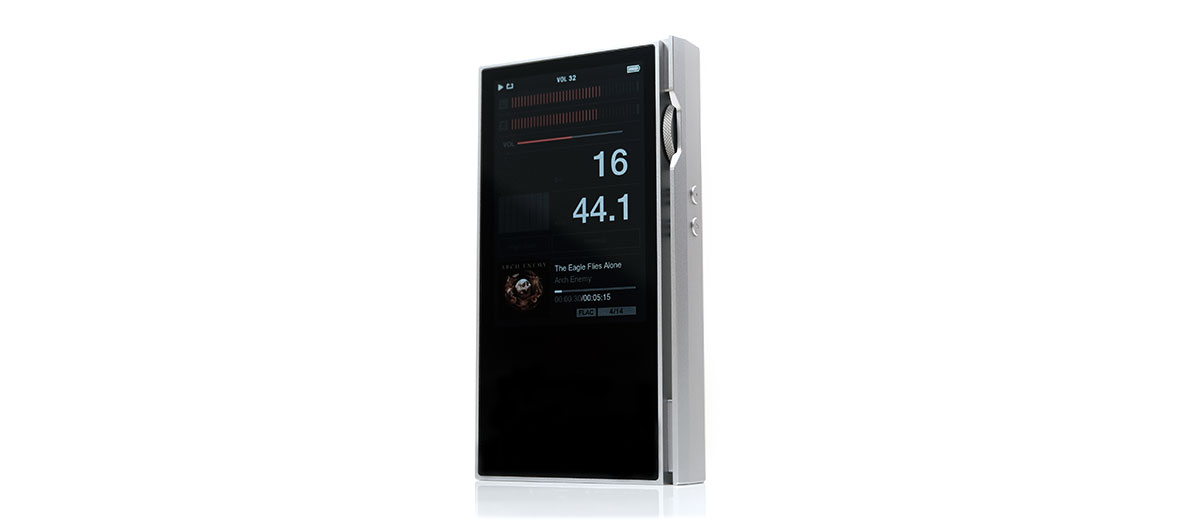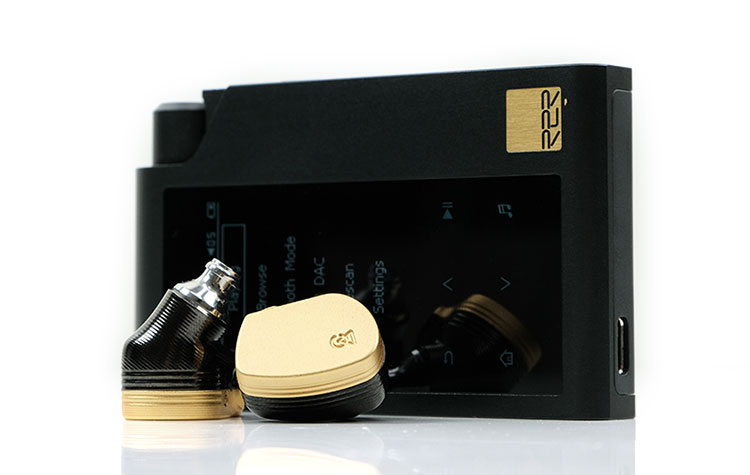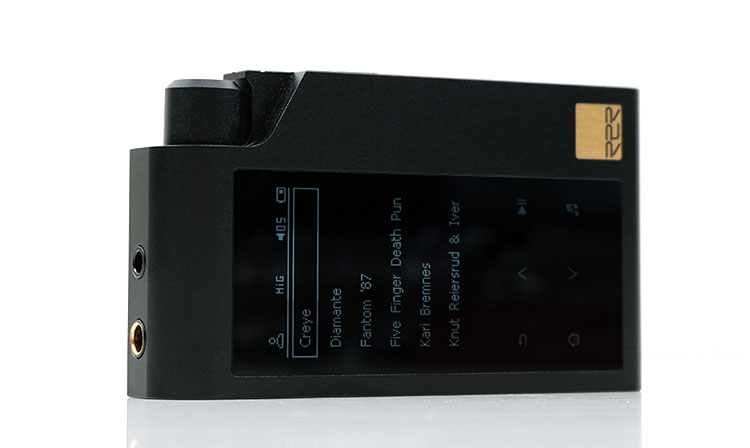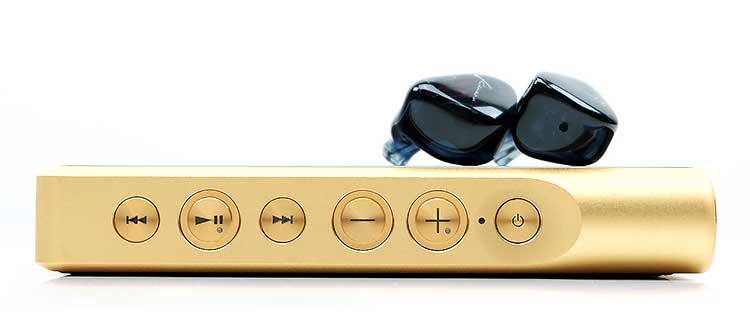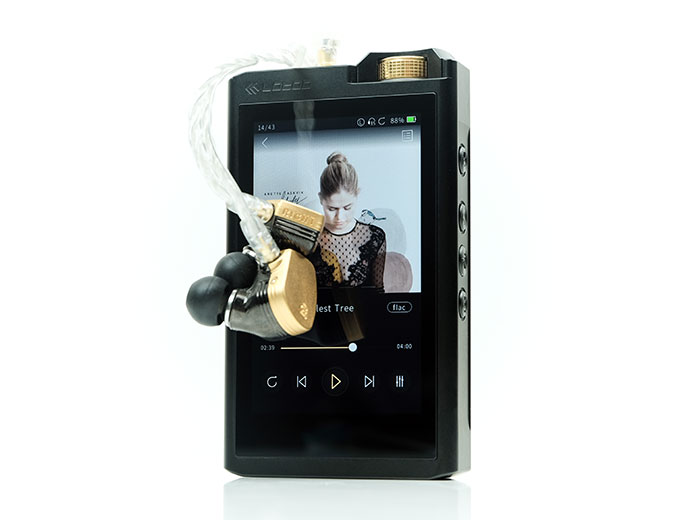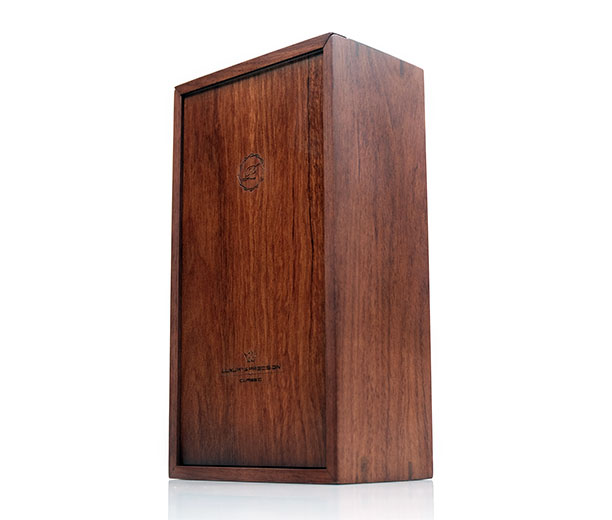Luxury & Precision P6 Synergy
Efficiency
The P6 has an extremely impressive low-noise floor with sensitive IEMs on both single-ended and balanced outputs. Not perfectly pitch black but for an R2R implementation, you will not find any annoying hiss with the likes of Campfire Audio’s Solaris, Andromeda 2020, or Ara.
Unbalanced
Unlike the Hifiman R2R2000, you do not need to go balanced with an ultra-low gain mode to achieve that, and also unlike both the Red and Black editions from Hifiman, you have a bit more micro-control over volume levels.
The stepped attenuator on the R2R2000 is normally only good for 5-10 steps on most monitors until you dip below 105dB SPL and ultra-low gain balanced where you can stretch high enough into the 15-20 region.
The electrical relay volume of the P6 is still relatively aggressive for volume but given the lighter power output on its single-ended output, it is more suited to monitors with a good 10 steps more useable volume.
Balanced
For balanced with sensitive monitors such as the Solaris, the volume comes right in on the first step but seem a little steady with a more gradual upswing from steps 2-8, then it gets a bit loud on step 9.
With the likes of the Odin and the Sultan, you get a lot more useable volume headroom going balanced on the P6. And I do prefer balanced over unbalanced for those wondering. The dynamic range and harmonic balance felt snappier and more accurate respectively.
Power
At 700mW into a 32Ω load, the P6’s balanced output is the way to go for all but the easiest of headphones to drive. 180mW into 32Ω single-ended really is not where you want to be if you own even modern planars like the Meze Empyrean and Final D8000 Pro, never mind the current-heavy variants such as the Abyss Diana Phi.
700mW is still shy of the DX220 MAX’s 1.7mW of power and the R8s’s 1W so it is not the most powerful out there in terms of pure voltage grunt. Having said that, up until this year 700mW would be a very acceptable level of power for most DAPs so things do change quite quickly for media player tech specs.
Planar Pairings
I was half expecting the P6 to be a little too smooth for the already smooth sound of the Empyrean but it surprised me for its rich impactful sound and much better than expected headroom. The P6 has some excellent current on-demand beyond its initial 55 steps volume control so you will have no problems powering the Empyrean.
You still get vocals to the fore but the detail the P6 can tease out of the timbral performance of the Empyrean is excellent. Staging width and depth also are impressive with a low-end that is tight but meaty with plenty of depth.
You will get enough headroom and volume from the Hifiman HE1000 V2 and tonally they are an excellent pairing with the P6 keeping some of those aggressive upper mids tendencies of the V2 in check. Again current headroom is excellent and you will have no shortage of volume with the HE1000 V2, especially with the last 5 steps in high gain.
Dynamic Driver
The Sennheiser HD660s was a more topical balanced output pairing because I found how well it performed on the P6 related to how much you like the HD660S/650 sound.
Personally, I felt the relaxed nature of the P6 treble did not gel as well as I would like with the already relaxed HD660S treble. The Hifiman R2R2000 vocal body isn’t as good as the P6 but it does tease out a bit more sparkle from the HD660s which some might prefer.
A far more agreeable pairing is the old-school HD600 which just rocked with the P6, (balanced). Nothing felt out of whack, too shouty or lacking in substance despite its fairly demanding 300Ω load. It still will not deliver huge bass, it simply was never tuned to give you that slam. However, with the P6 it does sound solid and impactful.
The mids, as you would expect, were front and center but with a treble lacking in harshness they will never sound edgy or sibilance with the P6. Big? Yes. Shouty and edgy? Nope.
Select Comparisons
Hifiman R2R2000 Black
$2500
Technical
The R2R2000 listed as a BT streamer and is not being marketed as DAP by Hifiman. However, to all extents and purposes, it is being used as one by most who buy it. This is also an R2R discreet implementation and uses 2 R2R PCM1704k chipsets whereas the P6 uses a 100% discreet conversion design equivalent to 8 PCM1704K chipsets.
Whilst neither will offer delta-sigma capable DSD512 and PCM 32BIT/768kHz, the P6 does offer a higher decoding capability compared to the R2R2000. It is capable of up to 32BIT/384kHz PCM and DSD256 compared to the R2R2000’s lower 24bit/384kHz PCM and DSD64.
The P6 also has a bit more output power for balanced at 700mW into a 32Ω load compared to the R2R2000’s 500mW into the same load. However, the R2R2000 offers a higher output rating for single-ended at 320mW compared to 180mW into the same load @1kHz.
There are some pros and cons to this, however. Yes, the P6 3.5mm TRS output is weaker voltage-wise, but it is quieter with a less aggressive gain than the R2R2000 unbalanced. The R2R2000 has a good gain control going unbalanced so it’s quite quiet but there is more hiss going unbalanced with its more limited gain control.
The P6, however, is the quieter of the two for both balanced and unbalanced with a better SNR and THD+N performance of 123dB and 0.003% respectively compared to the R2R2000’s rating of 115dB @ +/-3dB and 0.006%. You do get a lot more current control on the P6 volume compared to the R2R2000.
Both devices offer LDAC Bluetooth receiver capability which feels tacked on but tidy on the P6 and of course, it is the main thrust of the product pitch on the R2R2000.
Design
The R2R2000 is tiny, very pocketable with a very ergonomic shape, certainly much smaller than the P6. The P6 is a more traditional boxy shape, thicker but beautifully designed. I give an edge to the P6’s aesthetics with the bigger more legible color screen but there is no denying the handling comfort of the very light (142g) R2R2000 form factor.
Both offer microSD external memory but the P6 goes further with 64GB onboard memory whereas the R2R2000 has none. The two devices also have USB-C ports with USB-DAC, charging capability though no direct data transfer for the R2R2000. The R2R2000 does offer OTG digital audio via its USB-C which the P6 does not do.
Both have memory limits, however, though the P6 is double at 12k and the R2R2000 at around 6k tracks.
The battery numbers are better than what you would expect with the P6 coming close to 15 hours and the R2R2000’s eco mode offering well above 20 hours on a normal cycle. Of course, the R2R2000 eco mode gimps a lot of useful functionality but with it turned off it drops way down to under 10 hours.
Software
Neither are touch-capable though the R2R2000 physical controls below the screen are touch-sensitive rather than physical. However, I do not find the touch button implementation on the R2R2000 to have a huge advantage compared to the P6.
Still, the P6 larger screen and snappy OS response are much easier to use than the tinier R2R2000 black and white screen. It’s more intuitive with better media management and a nicer playback screen.
The P6 also has a lot more options to control from the OS such as DSD and PCM filters, EQ, and USB connectivity modes. It also has a metatag media library with artwork and playlist management whereas the R2R2000 is pure folder navigation.
Performance
These are good examples of using the same chipsets but able to design very different sound signatures. The R2R2000 is cleaner, brighter with more treble presence, and overall a bit more bass/treble contrast in its presentation.
The P6 is warmer, thicker, and richer with a broader and more rounded timbre to its notes and a presentation that draws you closer to the mids and low-end. It has less of a bass/treble contrast preferring instead to tease out a bit more grit and detail in vocal and instrumental texture. The sound is liquid, ‘phat’ in a way but with excellent separation and clarity.
The R2R2000 seems to tease out a mild v-shaped sensibility from the Odin with a punchier bass response and a more forward upper mids/lower treble presence. There is also a bias to odd harmonic partial overtones on instrumental and vocal timbre with slightly less body.
Certainly, the treble extension is better on the R2R2000 but as a result, the vocals on the R2R2000 Black can sound a shade sharper on clean recordings compared to the P6 which I find more natural and forgiving.
Overall, the R2r2000 is a cleaner with a more vivid high contrast style of sound while the P6 delivers a natural liquid-like tone with a meatier smoother timbre and generally a more forgiving presentation.
Sony NW-WM1Z
$3199
The ‘1Z’ has been out for a few years now and still their TOTL or flagship DAP. Sony has felt no need to enhance with a Pro or Gen 2 and let’s be thankful for that given the price they sell for.
DAC
Inside, Sony has gone proprietary with their own S-Master HX system compared to the R2R DAC of the P6. Both are very different implementations but decoding levels are the same with both happily decoding up to DSD256 and PCM 384kHz/32BIT.
However, native DSD decoding on the Sony is only via the balanced output where going unbalanced will have it converted to PCM. The R2R2000 will natively decode up to DSD256 and you can choose whether to go native or PCM via the OS for either output.
Much of this has to do with the use of a digital amplifier design of the 1Z and how Sony, by opting at keeping the signal in the digital domain right up to the LPF, has shaped what each output will do. Clearly by not allowing native DSD and a lower amp output for 3.5mm they have gone for better battery life.
Both devices can receive a BT signal, and both can offer top-level LDAC capability. The Sony is bi-directional for BT but neither DAP offers WiFi or apps expandability. Both do offer excellent DSP but the Sony is more evolved with their filtering whereas the graphical EQ on the P6 is more limited to a few presets and standard digital filters.
Amplifier
The P6 amplification is far superior for headphones and demanding IEMs with up to 700mW balanced and 180mW single-ended into a 32Ω load. The 1Z is much the weaker at 250mW balanced and 60mW unbalanced per channel and that is on an even lighter 16Ω load.
If you are thinking well, that’s great because the 1Z will be quiet, then that is not always the case with the Sony player. It can emit noise and background hiss on sensitive IEMs and there are times the P6 can seem the quieter of the two, depending on the IEM you choose.
The P6 also offers a dedicated lineout with 2 voltage settings whereas with the Sony you are going directly from the PO and therefore double-amping. Neither offer OTG though with Sony you can buy a proprietary cable for digital audio.
Design
The 1Z, beautifully designed it maybe is nevertheless a brick. There is no getting around that at 455g compared to just 248g for the P6. Much of that weight is from the gold-plated oxygen-free copper chassis that is also very striking looking. Still, if you want something more pocketable, the P6 is the way to go.
I would not call the 854 x 480 FWVGA panel top-tier on the Sony these days but it is much more useable and touch-friendly than the P6 non-touchscreen and command button system.
Both have 4.4mm balanced and 3.5mm unbalanced as well as digital I/O for USB-DAC but I much prefer the P6 USB-C universal connector to Sony’s fussy 30-pin proprietary interface.
The battery life of 1Z is probably one of the best in the business at this level with up to 30 hours, even with hi-res playback. The P6 does quite well at 15 hours on paper but once you work BT and hi-res into daily use you will find it drops a little.
Software
Both have a proprietary OS and whilst I think the Lotoo OS is better than the Sony version, it is considerably slicker looking than the simpler P6 OS.
You get a lot more EQ options, digital filters, NFC, a massive 256Gb onboard memory to tap into as well as external memory slots that are recognized as mass storage on PC and MAC. The screen is GUI capable so media management is also much easier.
However, the big drawback of the Sony OS is the boot time which is extraordinarily long as well as continually ‘creating the database’ after you update your media taking equally as long. The P6 software could be considered much faster on those two points.
Performance
Both have a lilt towards ‘musicality’ as defined by a hint of warmth and a swinging low-end over anything overly neutral and linear in their delivery. However, I want to just focus a bit more on dynamic range and power because the P6 has more of both for me.
You do need to go balanced with the Sony to get tease out its full potential but even with something like the Odin you are over 80 on the volume whereas the P6 sits comfortably at less than 40% going balanced.
Even when current or volume levels have matched you can tell the P6 has a slight edge in dynamic range sounding more open and expansive when notes come in and out at a fast pace. The Sony will deliver a lovely tone but it sounds more centered, slightly further back, and not as complex or vibrant when imaging flashes in and out from left to right.
Mids Timbre
You can hear that in mids performances from our test IEMs. The Sony mids tended to just lack a bit of body and offered a smooth but glossier tone whereas the P6 mids felt richer with better texture teasing out a bit more detail.
The effect was most felt in female vocals with one, in particular, I tend to listen to, Nina Boldt. Her vocal pitch is often a head voice with an ethereal quality emphasized by a bright mix with reverb on a lot of her recordings.
With the Sony, it was clear, a little drier and smooth but also lacking in raw qualities you want to hear such as tiny cracks in vocal delivery, the roughness of a breath, or how it echoes in the reverb. You get more of that with the P6 plus a more liquid attack preventing any sharp nasties creeping in.
Treble Infusion
The 1Z does have is a little more treble presence though not in the same vein as the R2R2000 and the Lotoo. You tend it hear it more in little timbral overtones than an out and out treble splash. Often it presents itself in vocal sibilance with a little bit of hardness now and then or a slightly cleaner brighter percussion hit.
The P6 does not seem to have quite the same overtone on its timbre but at the same time does not sound comparatively attenuated beyond the upper mids. Both have similar headroom
Lotoo PAW Gold Touch
$3199
DAC
The PAW Gold Touch is $200 more than the P6 but I sort of look at it as the delta-sigma equivalent of the p6. It has its own proprietary OS, similar size and shape, and offering excellent audio quality.
However, there are some big differences. The Touch uses a delta-sigma AK4497EQ DAC as opposed to the P6’s discreet R2R implementation.
Decoding on the Touch is an impressive DSD512 and PCM 32BIT/768kHz via an AK4137EQ digital sample rate converter. The P6 is lower at DSD256 and PCM 32BIT/386kHZ but does not rely on single-chip computational processing, preferring instead for a bit by bit transformation into analog.
Amplifier
For amping, the Touch is unusual, (in today’s marketing-driven world), in that it offers 500mW into a 32Ω from both balanced and single-ended outputs. The P6 offers 700mW on the same load balanced so more powerful, but less so single-ended at 180mW into 32Ω.
You can drive headphones pretty well from both though the P6 has an edge. For single-ended, the lower output of the P6 keeps things quiet for sensitive IEMs but the Touch has a very black background for both balanced and unbalanced.
Both are line-out capable with 4.4mm and 3.5mm TRS output options. The two DAPs both have voltage adjustment capability for single-ended lineout (low and high gain).
Wireless
Both have Bluetooth but the Touch is an older BT4.1 SoC whereas the P6 uses BT5.0. Both can receive LDAC and lower codecs, however, and the Touch can transmit, (bidirectional), whereas the P6 can only receive. The two DAPs can operate as USB-DAC’s, however, the Lotoo can go further with OTG digital audio capability.
Design
I love both designs. They are modern, very nicely cut and not too gaudy. The finishing on the Touch and P6 is exquisite and the form factor is not too big to operate with one hand. The big difference though is the weight with the Lotoo weighing in at 311g compared to 248g for the p6. You will feel that difference right away.
There are some differences in favor of the Lotoo with touchscreen capability being the biggest factor. It does make the Lotoo seems more user-friendly and operations are a lot faster to execute. The screen is also a bit bigger and easier to read on the Lotoo than the smaller less dense P6 screen.
Both have external memory slots though the Lotoo is well behind with no onboard memory and an insistence on using full SD sized cards. The two DAPs also use USB-C for charging, data transfer, and USB-DAC functionality though the P6 lacks OTG.
Software
These are two very fast and stable OS on each DAP. They never freeze or do something that ends up making our head scratch. Boot up time is fast, perhaps faster on the Lotoo.
The Touch’s touchscreen does open up more possibilities and whilst the P6 is feature-rich for filters, USB control, and LO/PO options, the Lotoo is just a bit ahead with additional EQ and PMEQ controls that go deeper with more customization.
The media library is also more evolved on the Lotoo with better drill down grouping and more ambitious artwork integration throughout. One added bonus is OTA firmware updates from a very limited WiFi service on the Lotoo but both can also be locally updated with small firmware files.
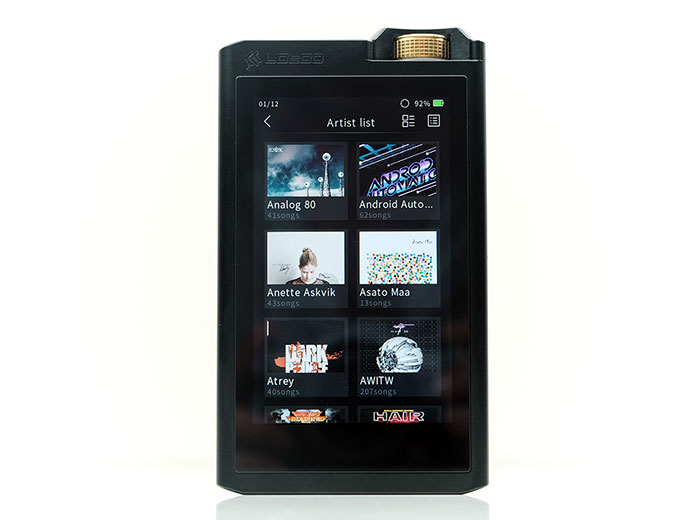
Performance
The differences are a little more nuanced on the Lotoo compared to the Sony and the R2R2000. It’s a great delta-sigma implementation, with a blacker background than any of the DAPs talked about in this review.
However, the tone is not quite as natural sounding as the p6, opting instead for a more neutral tone up the mids and a slight uptick in brightness through the to the upper treble. I said slightly because in most cases it’s not something that creates any harshness but you do notice it compared to the warmer gentle fade in the treble from the P6.
The P6 does sound a bit more weighted and denser on the low-end compared to the Touch. Its warmth is palatable and whilst the Lotoo does not lack anything in terms of punch but certainly not as muscular and dense as the bass from the P6 using our tested IEMs such as the Sultan and the Odin.
Vocals Timbre
The mids pretty much mirror that difference with the warmer more liquid delivery for both instruments and vocal coming from the P6 whereas the Lotoo is more neutral, slightly cleaner, and a vocal that is precise but with a comparatively ethereal quality.
What I mean by that is a slightly airier quality to the Lotoo upper mids, with more separation and air around the vocals but lighter in weight compared to the P6 vocals, particularly soprano singers and falsetto passages. The P6 vocal has a little less separation but a broader note and more rounded in the timbre using both the Odin and Sultan pairings.
You could call the Lotoo more articulate, more energetic but the P6 is more textured and natural in its delivery. Certainly, the power on the low-end from the P6 does make a qualitative difference to the PRaT of most gear I paired it with.
Our Verdict
The Luxury & Precision P6 DAP is a truly world-class sounding media player. On sound alone, it’s sumptuous, rich-sounding, beautifully detailed, and with an impressive black background for sensitive gear. It does wonders with note texture producing a natural sound that makes it so easy to pair with and listen to without fatigue. Probably the best sounding DAP I have heard in 2020.
However, the OS can be frustrating. Granted, it is fast and stable, well organized to a point, and easy to understand. But this is 2020 though, people’s muscles in their hands have adapted so much to touch typing and touch interactive screens that operating buttons and dials to get to somewhere in an OS is a hurdle that some will call a deal-breaker.
The Bluetooth is a fun cherry on top and does allow a way of streaming from the likes of TIDAL and Qobuz to the P6. It sounds very good actually in terms of the competition, no faults there. I just think most will come for that amazing R2R wired sound.
This is a beautifully built pure sound player. A throwback to a time when nothing else really mattered. I can forgive the retro-vibe of the OS and non-touch control for that sound because you will be hard-pressed to find an equal unless you a total treble freak.
Luxury & Precision P6 Specifications
- Dimensions/weight: 124×67.3x20mm/248g
- Display 3.5-inch, IPS screen, resolution 480×320
- Body material: aviation aluminum
- Rear cover: glass
- Main control: 1812C
- DAC: Fully discrete R2R decoding
- Crystal oscillator: Low phase noise -160dB active crystal oscillator
- Op-amp: EXCELS V-O
- Amp: EXCELS EP-A
- Inductance: low internal resistance large current metal alloy inductance
- Button: ALPS
- Capacity: 64GB 24 Bit ECC FLASH
- Support extended capacity: 512GB micro SD card (TF)
- Use charger specifications: DC voltage input range 4.8-5.5V
- Battery capacity/type: 4000mA/H Lithium battery
- Lifetime: 15 hours
Digital Specifications
- Highest sampling rate support: PCM: 24Bit 384KHz, DSD: 11.2896MHz (DSD256)
- Support audio format: APE, AAC, ALAC, FLAC, WAV, MP3, WMA, DFF, DSF, AIFF, SACD-ISO
- EQ adjustment: 6 style adjustments
- HP output: 2-level gain adjustment
- Dop SPDIF: support
- Digital filter settings: 6 filter modes (including NOS)
- Output phase setting: 0 degrees/180 degrees
- USB connection mode: MSC mode/Audio mode
- USB DAC: support
- USB Audio delay setting: long delay mode/short delay mode
- DSD decoding settings: native DSD mode /DSD to PCM mode
3.5mm single-ended line output
- SNR: >123dB (single-ended)
- Dynamic range: >118dB (single-ended)
- Distortion + noise: <0.003%
- Frequency response: 20Hz-20KHz ± 0.8dB
- Channel separation:> 98dB 10K load
- Single-ended line output level: 2.45Vrms/1.55Vrms/ switchable design
4.4mm balanced line output
- SNR: >123.5dB (balanced)
- Dynamic range: >118.5dB (balanced)
- Distortion plus noise: <0.003%
- Frequency response: 20Hz- 20KHz ± 0.8dB
- Channel separation: > 115dB 10K load
- Single-ended line output level: 4.9Vrms/3.1Vrms/ switchable design
LO Output 3.5mm
- Maximum output power: @ 16ohm 330mW (distortion rate <0.0039% of on-load power)
- Maximum output power: @32ohm 180mW (distortion rate <0.003% of on-load power)
- Maximum output power: @300ohm 20mW (distortion rate <0.003% of on-load power)
- SNR:> 123dB
- Dynamic range: >118dB
- Distortion + noise: <0.003% @32ohm load
- Frequency response: 20Hz -20kHz ± 0.8dB
- Output impedance: 0.2 ohm
- Channel separation:> 75dB @32ohm load
- Output voltage (high volume): high gain 2.45Vrms, low gain 1.55Vrms
Balanced LO Output
- Maximum output power: @32ohm 700mW (distortion rate <0.003% of on-load power)
- Maximum output power: @100ohm 240mW (distortion rate <0.003% of on-load power)
- Maximum output power: @300ohm 80mW (Distortion rate <0.003% of on-load power)
- SNR: > 123.5dB
- Dynamic range: >118.5dB (balanced PO)
- Distortion + noise: <0.003%@32ohm
- Frequency response: 20Hz-20KHz ± 0.8dB
- Output impedance: 0.4ohm
- Channel separation:> 113dB 32ohm load
- Output voltage: high gain 4.9Vrms, low gain 3.1Vrms
Bluetooth
- Bluetooth version: 5.0
- Supported protocols: LDAC, APTX, APTXHD, APTXLL, AAC, SBC
- Transmission direction: Bluetooth of P6 is the receiving end
- Transmission distance: within 15 meters of unobstructed open space
- Bluetooth audio clock source: the clock generated by the FPGA is used as the clock source

